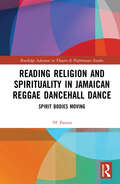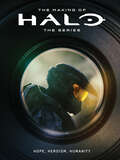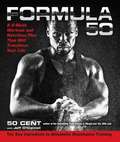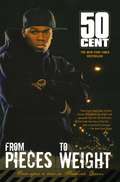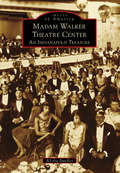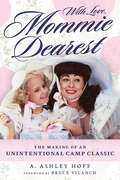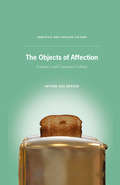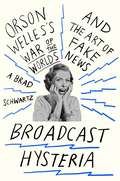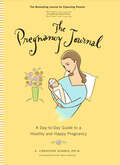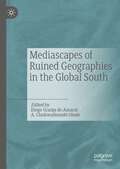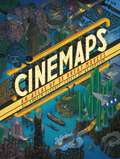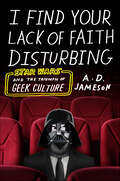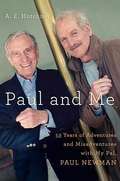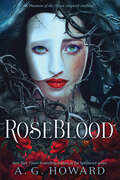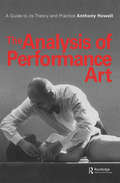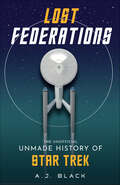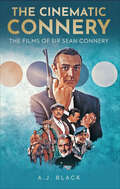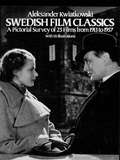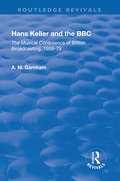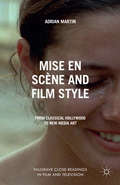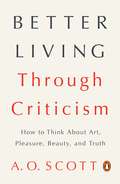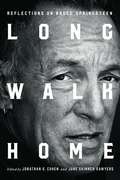- Table View
- List View
Reading Religion and Spirituality in Jamaican Reggae Dancehall Dance: Spirit Bodies Moving (Routledge Advances in Theatre & Performance Studies)
by 'H' PattenThis book explores the genealogy of Jamaican dancehall while questioning whether dancehall has a spiritual underscoring, foregrounding dance, and cultural expression. This study identifies the performance and performative (behavioural actions) that may be considered as representing spiritual ritual practices within the reggae/dancehall dance phenomenon. It does so by juxtaposing reggae/dancehall against Jamaican African/neo-African spiritual practices such as Jonkonnu masquerade, Revivalism and Kumina, alongside Christianity and post-modern holistic spiritual approaches. This book will be of great interest to students and scholars in performance studies, popular culture, music, theology, cultural studies, Jamaican/Caribbean culture, and dance specialists.
The Making of Halo The Series: Hope, Heroism, Humanity
by Microsoft 343 IndustriesOur deadliest weapon is our greatest hope.Get an exclusive, behind-the-scenes look at Paramount+&’s adaptation of the wildly popular Halo series. See what went into bringing the Master Chief and his team of Spartan supersoldiers to life in their war against the alien threat known as the Covenant.This book contains never-before-seen photographs from the sets, production artwork, shots of the props and armor, as well as commentary from the team that created the show!
Formula 50: A 6-Week Workout and Nutrition Plan That Will Transform Your Life
by 50 Cent Jeff O'ConnellGet fit like 50 Cent: The phenomenally fit superstar rapper reveals his strategic six-week workout plan for achieving a ripped body--and developing the mental toughness to stay in shape for a lifetime. Survival is a recurring theme of 50 Cent's lyrics, and his life. That's why, with obesity rates soaring and fitness levels declining, he wants to give everyone an all-access pass to his premium plan for lifelong fitness. In Formula 50, the mega-successful entertainer and entrepreneur unleashes the power of metabolic resistance training (MRT), the key ingredient that has helped him achieve the famously buff physique that makes his music videos sizzle. Through MRT, 50 Cent's fitness plan breaks down the barriers between traditional weight training and cardio workouts, accelerating fat loss while building muscle and improving overall fitness. Designed for a six-week rollout for total mind-body transformation, the Formula 50 regimen builds willpower while it builds physical power. This fitness book also focuses on nutrition-- readers will discover the unique dietary combinations that fuel 50 Cent's workouts. Coauthored with Jeff O'Connell, health journalist and editor-in-chief at Bodybuilding.com (the world's largest fitness website), the book delivers a payoff that goes beyond six-pack abs and flab-free pecs: This is a fitness plan that boosts energy, endurance, flexibility, and mobility. The result is a body you've always dreamed of--and the mindset to attain the rest of your dreams.
From Pieces to Weight: Once Upon a Time in Southside, Queens
by 50 Cent Kris ExGET RICH OR DIE TRYIN' That's what this book is about--the good times and the bad times. I wrote this book to explain the world I come from. To a lot of people, I may be too young to reflect on life. And they may be right. But I'd be wasting my blessings if I didn't use the attention I'm getting to shed light on the experiences that have caused me to say the things I say and make the kind of music I make. I want to explain my environment to those who don't come any closer to it than the records they buy or the images they see on television. People want the truth. Even if they can't handle it, they want it. I let you know that I survived nine bullets not to sell records, but because it's the truth. Every time I sit down for an interview, I'm asked, "Well, 50, how did it feel to get shot nine times?" But those stories don't hold the weight, the pain, or the hope of my experience. It just can't. This is my mindset and these are the things that go on. This is why I say the rhymes that I say. This is what happened when I was trying to get rich before I died in Southside Queens. So begins From Pieces to Weight: Once Upon a Time in Southside Queens, a violent and introspective memoir that reveals not only 50's story but the story of a generation of youth faced with hard choices and very little options. A tale of sacrifice, transformation and redemption, but it is also one of hope, determination and the power of self. Told in 50's own unique voice, the narrative drips with the raw insight, street wisdom, and his struggle to survive at all costs...and behold the riches of the American Dream. 50 Cent has sold over 20 million records worldwide. His record-breaking debut album Get Rich or Die Tryin' has sold over 12 million units worldwide, with the largest debut in SoundScan history. While his sophomore effort, The Massacre, sold over 1.14 million copies in its fi rst four days of release, he has since become the fi rst artist to have four songs in the top ten of Billboard's Hot 100 since The Beatles in 1964. His business empire includes: a record label (G-Unit Records, a division of Interscope Records), apparel/footwear ventures (G-Unit Clothing and footwear, joint ventures through the Ecko Clothing Company and Reebok, respectively), vitamin water (Formula 50, through Glacéau's Vitamin Water), watch line (G-Unit Watches, through Jacob & Co), and a video game (50 Cent: Bulletproof, through Vivendi Games). His future plans are to dominate the film and television worlds through two new G-Unit ventures in film and television...and his most prized project: the nonprofit organization The G-Unity Foundation, which aims to better the life of urban youth.
Madame Walker Theatre Center: An Indianapolis Treasure (Images of America)
by A'Lelia BundlesAs they watched construction of the block-long flatiron building brick by brick throughout 1927, African American residents of Indianapolis could scarcely contain their pride. This new headquarters of the Madam C.J. Walker Manufacturing Company, with its terra-cotta trimmed facade, was to be more than corporate offices and a factory for what then was one of America's most successful black businesses. In fact, it was designed as "a city within a city," with an African Art Deco theater, ballroom, restaurant, drugstore, beauty salon, beauty school, and medical offices. Generations of African American families met for Sunday dinner at the Coffee Pot, enjoyed first-run movies and live performances in the Walker Theatre, and hosted dances in the Casino. Today, this National Historic Landmark is an arts center anchoring the Indiana Avenue Cultural District.
With Love, Mommie Dearest: The Making of an Unintentional Camp Classic
by A. Ashley Hoff Bruce VilanchWhen she died in 1977, Joan Crawford was remembered as an icon of Hollywood's Golden Age—until publication the following year of her daughter's memoir, Mommie Dearest. Christina Crawford's book was an immediate bestseller, combining the infrequently discussed topic of child abuse with the draw of Hollywood drama. But when Paramount Pictures released the film version, starring Faye Dunaway as Crawford, it was panned, and it remains one of the most legendary critical bombs in film history. The lavish, big-screen adaptation drew unexpected laughter for its over the top the scenes depicting life in the Crawford household. Rarely have such good intentions been met with such ridicule. Despite this, the movie was a commercial success and remains, four decades later, immensely popular as an unintentional camp classic. Based on new interviews with people connected to the book and the film—from cast and crew members to industry insiders—With Love, Mommie Dearest details the writing and selling of Christina's book and the aftermath of its publication, as well as the filming of the motion picture, whose backstage drama almost surpassed what was viewed on-screen in the film.Hollywood historian A. Ashley Hoff explores the phenomenon, the camp, and the very real social issues addressed by the book and film.
The Objects of Affection: Semiotics and Consumer Culture (Semiotics and Popular Culture)
by A. BergerIn this book, pre-eminent semiotician Arthur Asa Berger decodes the meanings of common objects of consumption and their perceived 'sacredness' in consumerist cultures. Using semiotic theory, consumer culture is dissected in new and fascinating ways.
Broadcast Hysteria: Orson Welles's War of The Worlds and The Art of Fake News
by A. Brad SchwartzIn Broadcast Hysteria, A. Brad Schwartz examines the history behind the infamous radio play. Did it really spawn a wave of mass hysteria? Schwartz is the first to examine the hundreds of letters sent directly to Orson Welles after the broadcast. He draws upon them, and hundreds more sent to the FCC, to recapture the roiling emotions of a bygone era, and his findings challenge conventional wisdom. Relatively few listeners believed an actual attack was underway. But even so, Schwartz shows that Welles's broadcast prompted a different kind of "mass panic" as Americans debated the bewitching power of the radio and the country's vulnerabilities in a time of crisis. Schwartz's original research, storytelling, and thoughtful analysis make Broadcast Hysteria a groundbreaking work of media history.
The Pregnancy Journal: A Day-to-Day Guide to a Healthy and Happy Pregnancy
by A. Christine HarrisAn updated edition of the million-selling guide that accompanies you through the days, weeks, and months of your pregnancy.A modern classic translated into a dozen languages, The Pregnancy Journal provides daily entries that update you on your baby’s development—as well as guiding you through the best health and nutrition decisions for both of you.With more than a million-and-half copies sold worldwide, this one-of-a-kind guide is the ultimate resource for today’s expecting mother, now in its updated fourth edition.
Mediascapes of Ruined Geographies in the Global South
by Diego Granja do Amaral A. Chukwudumebi ObuteThis book undertakes an interdisciplinary and cross-cultural interrogation of the Global South through the prisms of media and cultural studies. It closely explores the quotidian (re)territorialization, and brazen ruination of the material geographies of this vast expanse of the world by forces and proxies of (neo)colonialism and global capitalism of resource extraction. We cite the ongoing expulsion of Palestinians from their homelands by occupational forces, the emerging detritus dump across Mexico City and Lagos, the infrastructural precariousness of the favelas of Brazil, the unending resource-war in the Democratic Republic of Congo (DRC), and the flagrant operation of the oil industry in the Niger Delta region of Nigeria as examples of this geographic cataclysm. The centripetal forces of neo-colonialism and resource extraction at full-flight in the Global South, aided by toxic hegemonic forces, have overtly tossed some of the population to the peripheries of existence and the society at large. As such, this book, additionally, explores the resistance of the subalterns from the margins to this socio-political malaise, and further unmasks the knowledge production from these margins of the Global South. This project is divided into five (5) parts of three essays each. The first part examines the territorial contestation in the Middle East framed and expressed through films and literary lenses. The second part examines the environmental burden of modern consumerism and urbanization on metropolis across Mexico, Brazil, and Nigeria, while the third part explores the attritional violence of resource extraction in the DRC, Brazil, and Nigeria via filmic and journalistic lenses. The fourth part offers a swift response from the margins through ethnographic and journalistic interrogation of the subjectivity of the subalterns of Brazilian favelas, and street artists. The fifth part offers an engaging critique of the political climates of South Africa and Brazil that reinforce the environmental catastrophe of the regions of the world.
Cinemaps: An Atlas of 35 Great Movies
by Andrew Degraff A. D. JamesonThis beautifully illustrated atlas of beloved movies is an essential reference for cinephiles, fans of great films, and anyone who loves the art of mapmaking. Acclaimed artist Andrew DeGraff has created beautiful hand-painted maps of all your favorite films, from King Kong and North by Northwest to The Princess Bride, Fargo, Pulp Fiction, even The Breakfast Club—with the routes of major characters charted in meticulous cartographic detail. Follow Marty McFly through the Hill Valley of 1985, 1955, and 1985 once again as he races Back to the Future. Trail Jack Torrance as he navigates the corridors of the Overlook Hotel in The Shining. And join Indiana Jones on a globe-spanning journey from Nepal to Cairo to London on his quest for the famed Lost Ark. Each map is presented in an 11-by-14-inch format, with key details enlarged for closer inspection, and is accompanied by illuminating essays from film critic A. D. Jameson, who speaks to the unique geographies of each film.
I Find Your Lack of Faith Disturbing: Star Wars and the Triumph of Geek Culture
by A. D. Jameson"Funny, incisive, and timely ... Jameson does for geeks what geek culture does for its superheroes: he takes them seriously, respects their power, and refuses to hide his deep affection." —Lawrence Kasdan, co-screenwriter of The Empire Strikes Back, Return of the Jedi, The Force Awakens, and Solo: A Star Wars StoryIn I Find Your Lack of Faith Disturbing, A. D. Jameson takes geeks and non-geeks alike on a surprising and insightful journey through the science fiction, fantasy, and superhero franchises that now dominate pop culture. Walking us through the rise of geekdom from its underground origins to the top of the box office and bestseller lists, Jameson takes in franchises like The Lord of the Rings, Guardians of the Galaxy, Harry Potter, Star Trek, and, in particular, Star Wars—as well as phenomena like fan fiction, cosplay, and YouTube parodies. Along the way, he blasts through the clichés surrounding geek culture: that its fans are mindless consumers who will embrace all things Spider-Man or Batman, regardless of quality; or that the popularity and financial success of Star Wars led to the death of ambitious filmmaking.A lifelong geek, Jameson shines a new light on beloved classics, explaining the enormous love (and hate) they are capable of inspiring in fan and non-fan alike, while exploding misconceptions as to how and why they were made. I Find Your Lack of Faith Disturbing tells the story of how the geeks have inherited the earth.
Paul and Me: Fifty-three Years of Adventures and Misadventures with My Pal Paul Newman
by A. E. HotchnerBestselling author A. E. Hotchner's intimate account of his 53-year friendship with his pal Paul Newman. A. E. Hotchner first met Paul Newman in 1955 when the virtually unknown actor assumed the lead role in Hotchner's first television play, based on an Ernest Hemingway story. The project elevated both men from relative obscurity to recognition and began a close and trusted friendship that lasted until Newman's death in 2008. In Paul and Me, Hotchner depicts a complicated, unpredictable, fun-loving, talented man, and takes the reader along on their adventures. The pair traveled extensively, skippered a succession of bizarre boats, confounded the business world, scored triumphs on the stage, and sustained their friendship through good times and bad. Most notably, they started Newman's Own as a prank and watched it morph into a major enterprise that so far has donated all its $300 million in profit to charities including the Hole in the Wall Camps worldwide, dedicated to helping thousands of children with life-threatening illnesses. Paul and Me, complete with personal photographs, is the story of a freewheeling friendship and a tribute to the acclaimed actor who gave to the world as much as the world gave him.From the Hardcover edition.
Sophia: Living and Loving
by A. E. HotchnerBiography of the famous actress Sophia Loren up to 1979.
RoseBlood: A Phantom of the Opera–Inspired Retelling
by A. G. HowardFrom the bestselling author of the Splintered series, a talented young opera singer enrolls in a French performing arts school shrouded in mystery.Rune has a mysterious affliction that’s linked to her musical talent. Her mother believes creative direction will help, so she sends Rune to a French arts conservatory rumored to have inspired The Phantom of the Opera. When Rune begins to develop a friendship with the elusive Thorn, she realizes that with him, she feels cured. But as their love grows, Thorn is faced with an impossible choice: save Rune or protect the phantom haunting RoseBlood, the only father he’s ever known.Fans of Daughter of Smoke & Bone and the Splintered series will adore this retelling of one of the most famous stories of all time.Praise for RoseBlood“The Phantom of the Opera is reborn in this supernatural tale of music, passions, and love. . . . A rich, atmospheric story that readers will be hard-pressed to put down.” —Kirkus Reviews“Rune is a multifaceted, artistic character whose actions and reactions feel believably young adult as she confronts questions about family secrets and heredity. This is an accomplished undertaking. . . . VERDICT A good purchase for paranormal romance collections, and the connections to a classic work of literature add appeal.” —School Library Journal
The Analysis of Performance Art: A Guide to its Theory and Practice
by Anthony Howell A. HowellThis finely illustrated book offers a simple yet comprehensive 'grammar' of a new discipline. Performance Art first became popular in the fifties when artists began creating 'happenings'. Since then the artist as a performer has challenged many of the accepted rules of the theatre and radically altered our notion of what constitutes visual art. This is the first publication to outline the essential characteristics of the field and to put forward a method for teaching the subject as a discipline distinct from dance, drama, painting or sculpture.Taking the theory of primary and secondary colours as his model, Anthony Howell posits three primaries of action and shows how these may be mixed to obtain a secondary range of actions. Based on a taught course, the system is designed for practical use in the studio and is also entertaining to explore. Examples are cited from leading performance groups and practitioners such as Bobbie Baker, Orlan, Stelarc, Annie Sprinkle, Robert Wilson, Goat Island, and Station House Opera. This volume, however, is not just an illustrated grammar of action - it also shows how the syntax of that grammar has psychoanalytic repercussions. This enables the performer to relate the system to lived experience, ensuring a realisation that meaning is being dealt with through these actions and that the stystem set forth is more than a dry structuring of the characteristics of movement.Freud's notion of 'transference' and Lacan's understanding of 'repetition' are compared to a performer's usage of the same terms. Thus the book provides a psychoanalytic critique of performance at the same time as it outlines an efficient method for creating live work on both fine art and theatre courses.
The Oxford Guide to Word Games
by Tony Augarde A. J. AugardeRiddles such as this are just one of the forms of linguistic gymnastics explored in this invaluable source-book. Unique in its thematic and historical approach to the subject, it will tell you everything you ever wanted to know about word games and wordplay, and is entertaining as well as informative. The Oxford Guide to Word Games quickly established itself as the authoritative work on the subject when it was first published in 1984. It not only described all the major word games but also traced their origins and placed them in their social context. Now thoroughly revised, enlarged, and updated to make it even more valuable and comprehensive, this edition includes several new chapters, covering topics such as homonyms and slips of the tongue. New material has also been added on many topics including crossword clues, blends, and kangaroo words. Book jacket.
Lost Federations: The Unofficial Unmade History of Star Trek
by A. J. Black"An innovative and unusual account of Star Trek’s lost voyages that makes for a fascinating alternate history." — Brian J. Robb in Sci-Fi Bulletin SPACE. THE FINAL FRONTIER. THESE WERE ALMOST THE VOYAGES OF THE STARSHIP ENTERPRISE. We think we know the history of Star Trek. Born at the height of 1960s popular culture, the five-year mission of Captain James T. Kirk and his crew faced early cancellation, bounced back with a series of beloved movies in the 1980s and gave way to a fleet of successful sequels and spin-offs that kept on exploring strange new worlds. In Lost Federations: The Unofficial Unmade History of Star Trek, author A. J. Black tells a different story. This is an alternate history of the franchise, one filled with roads not taken, from early 1960s feature-films and spin-offs, the original sequel Star Trek: Phase II in the 1970s, via epic planned movies such as Planet of the Titans and into many untold episodes, arcs and character stories from The Next Generation, Deep Space Nine and Voyager, all the way through to the modern era. Bringing together pre-existing material over decades for the first time in one space, plus some new reflections from Star Trek writers and analysis of how it all fits into the wider cultural trends of the last sixty years, Lost Federations invites you to boldly explore a history you may not already know...
The Cinematic Connery: The Films of Sir Sean Connery
by A. J. BlackScotland’s greatest export. The world’s first super spy. Voted the sexiest man on the planet. Sir Sean Connery was a titanic figure on screen and off for over half a century. Behind the son of a factory worker, growing up in near-poverty on the harsh streets of pre-war Edinburgh, lay a timeless array of motion pictures that spanned multiple decades and saw Connery work across the globe with directors as diverse as Alfred Hitchcock, Steven Spielberg and Michael Bay. And amongst them his greatest role, whether he liked it or not – Bond, James Bond. Author A. J. Black delves into Connery’s life for more than mere biography, exploring not just the enormously varied pictures he made including crowd pleasing blockbusters such as The Untouchables or Indiana Jones and the Last Crusade, serious-minded fare in The Hill or The Offence, and his strange sojourns into eclectic fantasy with Zardoz or Time Bandits, but also the sweep of a career that crossed movie eras as well as decades. From skirmishes with the angry young men of the British New Wave, via becoming the cinematic icon of the 1960s as 007, through to a challenging reinvention as a unique older actor of stature in the 1980s, this exploration of the Cinematic Connery shows just how much his work reflected the changing movie-going tastes, political realities and cultural trends of the 20th century, and beyond . . .
Swedish Film Classics
by A. KwiatkowskiMemorable stills from great cinematic tradition -- Ingeborg Holm (1913) to Wild Strawberries (1957). Complete credits, synopsis, commentary for each film. Introduction, critical biographies of directors.
Hans Keller and the BBC: The Musical Conscience of British Broadcasting 1959-1979
by A. M. GarnhamOriginally published in 2003, Hans Keller and the BBC is a vivid portrait of the changing face of British broadcasting seen through the work of one of its most significant personalities. Starting with an examination of Keller’s early psychological interests, and the evolution of his method of ‘functional analysis’ of music (with which the BBC was intimately concerned), the book charts the huge contribution Keller made to British music during his BBC years. Also explored in detail are the successive crises of the Third Programme and its replacement by Radio 3, together with Keller’s leading role in opposing the decline of the BBC’s cultural idealism. Drawing on a wealth of primary sources, much of which has never been previously examined, this study paints a striking picture of Keller’s personality in combination with the BBC’s turbulent inner workings, showing the effect of one remarkable individual on the most powerful musical institution in 20th-century Britain.
Mise en Scène and Film Style: From Classical Hollywood to New Media Art (Palgrave Close Readings in Film and Television)
by A. MartinStyles of filmmaking have changed greatly from classical Hollywood through to our digital era. So, too, have the ways in which film critics and scholars have analysed these transformations in film style. This book explores two central style concepts, mise en scène and dispositif, to illuminate a wide range of film and new media examples.
Better Living Through Criticism
by A. O. ScottThe New York Times film critic shows why we need criticism now more than everFew could explain, let alone seek out, a career in criticism. Yet what A.O. Scott shows in Better Living Through Criticism is that we are, in fact, all critics: because critical thinking informs almost every aspect of artistic creation, of civil action, of interpersonal life. With penetrating insight and warm humor, Scott shows that while individual critics--himself included--can make mistakes and find flaws where they shouldn't, criticism as a discipline is one of the noblest, most creative, and urgent activities of modern existence.Using his own film criticism as a starting point--everything from his infamous dismissal of the international blockbuster The Avengers to his intense affection for Pixar's animinated Ratatouille--Scott expands outward, easily guiding readers through the complexities of Rilke and Shelley, the origins of Chuck Berry and the Rolling Stones, the power of Marina Abramovich and 'Ode on a Grecian Urn.' Drawing on the long tradition of criticism from Aristotle to Susan Sontag, Scott shows that real criticism was and always will be the breath of fresh air that allows true creativity to thrive. "The time for criticism is always now," Scott explains, "because the imperative to think clearly, to insist on the necessary balance of reason and passion, never goes away."From the Hardcover edition.
Long Walk Home: Reflections on Bruce Springsteen
by Richard Russo Eric Alterman David L. Ulin Paul Muldoon Wesley Stace Elijah Wald Daniel Wolff Peter Ames Carlin Regina Barreca Greil Marcus Kenneth Womack Jim Cullen Dermot Bolger Deepa Iyer Jefferson Cowie A. O. Scott Joel Dinerstein Nancy Bishop Gillian G. Gaar Louis Masur Natalie Adler Martyn Joseph Lauren Onkey Colleen Sheehy Frank Stefanko Irwin Streight Wayne SwanBruce Springsteen might be the quintessential American rock musician but his songs have resonated with fans from all walks of life and from all over the world. This unique collection features reflections from a diverse array of writers who explain what Springsteen means to them and describe how they have been moved, shaped, and challenged by his music. Contributors to Long Walk Home include novelists like Richard Russo, rock critics like Greil Marcus and Gillian Gaar, and other noted Springsteen scholars and fans such as A. O. Scott, Peter Ames Carlin, and Paul Muldoon. They reveal how Springsteen’s albums served as the soundtrack to their lives while also exploring the meaning of his music and the lessons it offers its listeners. The stories in this collection range from the tale of how “Growin’ Up” helped a lonely Indian girl adjust to life in the American South to the saga of a group of young Australians who turned to Born to Run to cope with their country’s 1975 constitutional crisis. These essays examine the big questions at the heart of Springsteen’s music, demonstrating the ways his songs have resonated for millions of listeners for nearly five decades. Commemorating the Boss’s seventieth birthday, Long Walk Home explores Springsteen’s legacy and provides a stirring set of testimonials that illustrate why his music matters.
The Puppy Pianist: A fun children's book for boys and girls age 6 and up
by A. P. HernándezWilliam’s a piano teacher and Lola is his inseparable Maltese Bichon dog. Lola has always been surrounded by music because she loves listening to her owner play his wonderful instrument. One day, Lola decides to jump onto the piano bench. She’s very clear about it: she is going to be a puppy pianist. What's inside? •A fun story with numerous illustrations to make reading more enjoyable. •A captivating tale to encourage the habit of reading; it offers children a story that matches their interests. Educational value of this book: •Increases vocabulary. •Promotes self-esteem because Lola's story can help children feel more confident. •Teaches children that we all have special talents that make us unique and valuable. •Fosters resilience because Lola confronts challenges throughout the story. A children's book for ages 6 and up.
